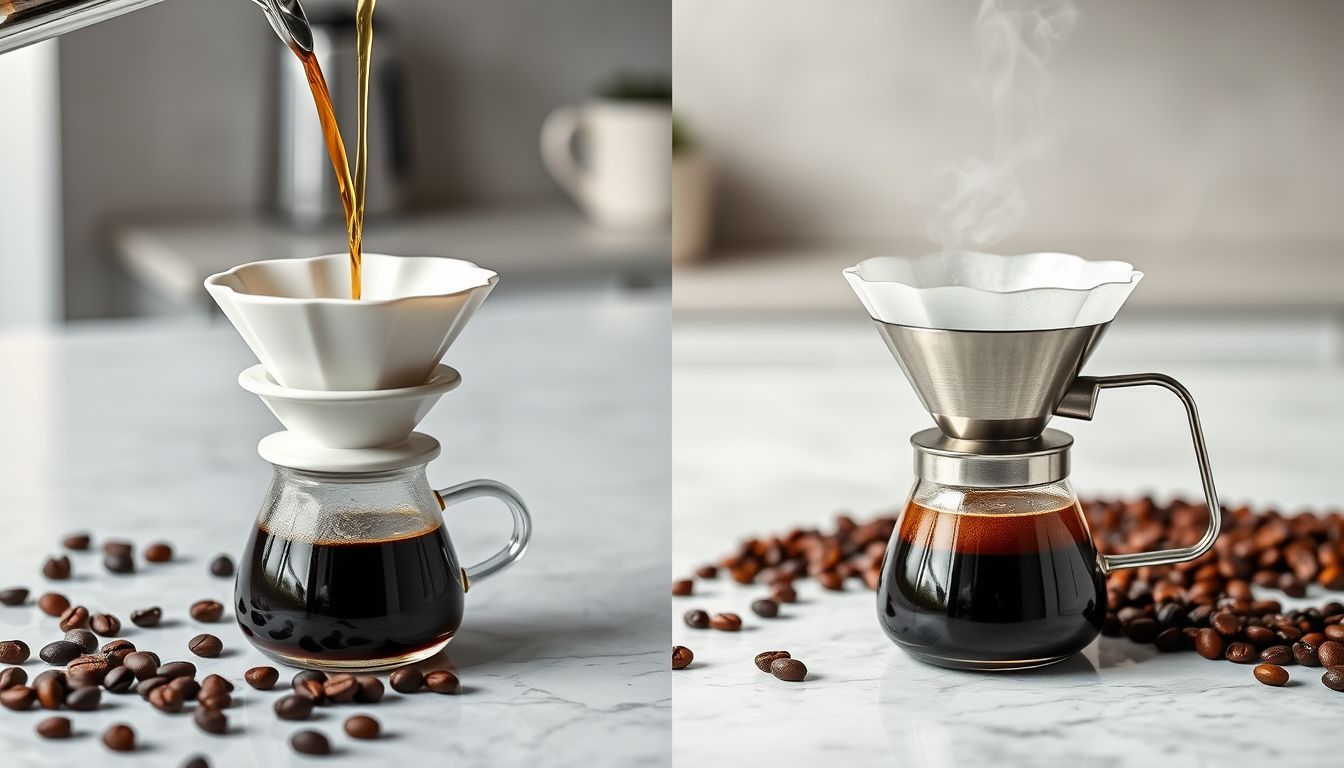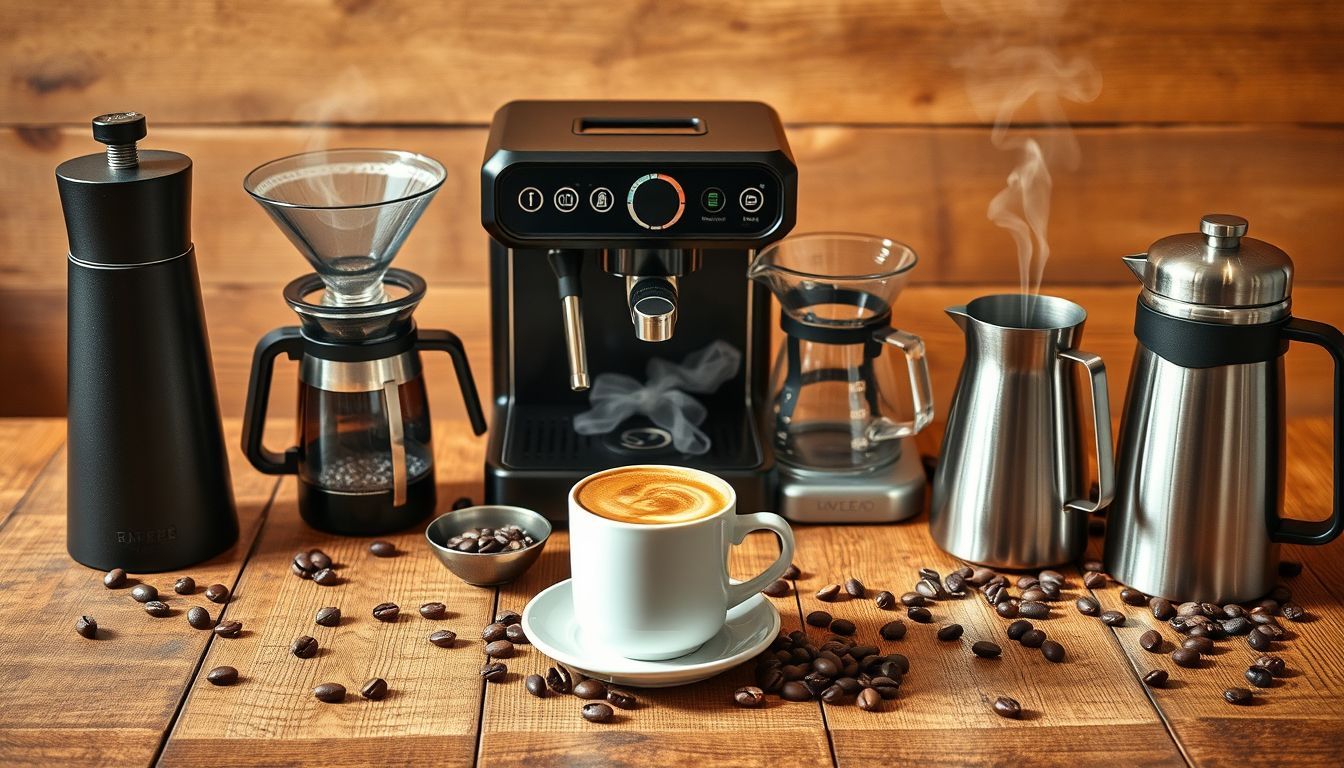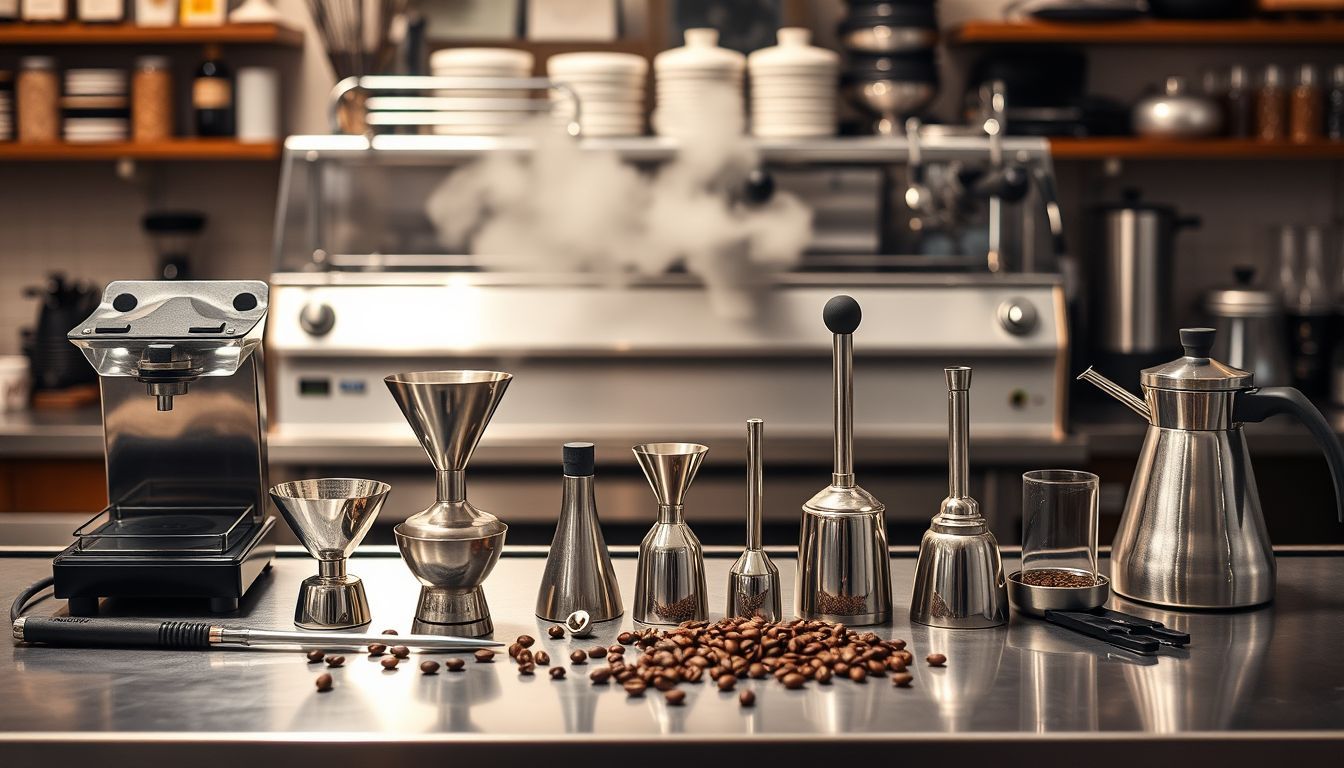Why Ceramic vs Metal Coffee Equipment Changes Everything (And When It Doesn't)
Material choice in coffee equipment affects thermal properties, flavor neutrality, and brewing performance. Discover when ceramic vs metal actually matters for your coffee quality.

Amazon Affiliate Disclosure
This post contains affiliate links. If you purchase through these links, we may earn a small commission at no additional cost to you.
Why Ceramic vs Metal Coffee Equipment Changes Everything (And When It Doesn't)
Last month, I conducted an experiment that would make materials scientists proud and coffee purists nervous. I brewed identical coffee using ceramic and stainless steel versions of the same pour-over dripper, maintaining every variable except the material. The results were subtle but measurable—and completely different from what most people expect.
The ceramic version didn't produce "warmer, more rounded" flavors as coffee folklore suggests. The stainless steel didn't create "brighter, more metallic" notes as conventional wisdom claims. Instead, the differences lay in thermal behavior, heat retention, and extraction timing—factors that affect coffee quality in ways that have nothing to do with mystical material properties.
This experiment crystallized something I've observed throughout years of equipment testing: the ceramic versus metal debate in coffee equipment is simultaneously overblown and underappreciated. Overblown because material choice rarely affects flavor directly. Underappreciated because thermal properties can significantly impact brewing performance in specific scenarios.
Today, we're diving deep into the science behind material choice in coffee equipment, separating marketing mythology from measurable performance differences, and building a framework for when material actually matters versus when it's just expensive aesthetics.
The Science of Materials in Coffee Brewing
Before exploring specific equipment categories, let's understand how material properties actually affect coffee extraction.
Thermal Properties: The Real Differentiators
Heat Capacity (Thermal Mass)
Ceramic has significantly higher heat capacity than most metals, meaning it absorbs and stores more thermal energy. When you pour hot water into a ceramic brewing device—like the iconic Hario V60 Ceramic Coffee Dripper, Size 02, White—more energy goes into heating the dripper itself, potentially lowering water temperature.
Stainless steel has lower heat capacity, absorbing less energy from brewing water. This means more thermal energy remains available for coffee extraction.
Thermal Conductivity
Ceramic conducts heat slowly, acting as an insulator. Once heated, it maintains temperature steadily but takes time to reach thermal equilibrium.
Stainless steel conducts heat rapidly, quickly reaching the temperature of its contents but also losing heat to the environment faster.
Real-world impact: These differences create measurable effects in brewing temperature and timing, especially in longer extraction methods.
Chemical Interactions: Separating Fact from Fiction
Flavor Neutrality Claims
High-quality ceramic is chemically inert—it doesn't react with coffee compounds or leach flavors. This neutrality is why ceramic is preferred for laboratory equipment and wine storage.
Food-grade stainless steel (304 or 316 grades) is also chemically inert under normal coffee brewing conditions. Claims about metallic flavors from quality stainless steel are largely unfounded.
The Exception: Lower-grade metals (aluminum, some steel alloys) can interact with acidic coffee, but these materials are rarely used in quality coffee equipment.
Surface Properties and Maintenance
Porosity and Cleaning
Ceramic surfaces are non-porous and easy to clean completely, though they can stain over time from coffee oils.
Stainless steel surfaces are also non-porous but may show water spots or fingerprints more readily than ceramic.
Durability Considerations
Ceramic resists scratching and chemical damage but is vulnerable to impact and thermal shock.
Stainless steel resists impact and thermal shock but can scratch or dent with abuse.
Pour-Over Equipment: Where Material Choice Matters Most
Thermal Mass Effects in Pour-Over Brewing
Ceramic Pour-Over Performance
Hario V60 Ceramic vs. Stainless Steel Testing:
Using identical coffee, grind, and pouring technique:
- Temperature retention: Ceramic version maintained higher average temperature throughout 4-minute brew
- Heat absorption: Initial water temperature dropped 3-4°F more in ceramic version
- Extraction consistency: Ceramic showed more stable extraction rates
- Flavor impact: Subtle differences in body and clarity, with ceramic producing slightly fuller body
Why ceramic excels: The thermal mass creates a more stable brewing environment, reducing temperature fluctuations that can affect extraction consistency.
Link for ceramic dripper: Hario V60 Ceramic Coffee Dripper, Size 02, White
Stainless Steel Advantages
Chemex Comparison (Glass vs. Hypothetical Steel):
While Chemex only comes in glass, testing with a similar-design steel dripper—such as the LHS Pour Over Coffee Dripper Stainless Steel Coffee Filter Metal Cone Filter Paperless Reusable Coffee Filter Single Cup—reveals:
- Faster heat transfer: Steel drippers reach brewing temperature quickly
- Lower heat absorption: More thermal energy available for extraction
- Durability: Unbreakable for travel or commercial use
- Maintenance: Easier to clean thoroughly
When steel excels: Quick brewing methods where thermal stability is less critical than thermal efficiency.
Practical Performance Differences
Brewing Method Optimization
Slow Pour-Over (6+ minutes):
- Ceramic advantage: Thermal stability maintains consistent extraction
- Steel disadvantage: Heat loss can lead to under-extraction in later stages
Fast Pour-Over (3-4 minutes):
- Steel advantage: Rapid thermal response, minimal heat absorption
- Ceramic disadvantage: Thermal mass may cool water unnecessarily
Pulse Pouring:
- Ceramic advantage: Maintains temperature between pours
- Steel performance: Adequate but more sensitive to timing
Gooseneck Kettles
Precise temperature and pour control are critical to exploit these material differences. A gooseneck kettle with accurate presets helps maintain brew consistency. We recommend the COSORI Electric Gooseneck Kettle with 5 Temperature Control Presets for its rapid heating and precise pour spout design.
Espresso Equipment: Material Impact on Performance
Portafilter and Group Head Materials
Thermal Stability in Espresso
Brass vs. Stainless Steel Group Heads:
Commercial espresso machines often use brass for thermal mass, while home machines frequently use stainless steel for cost and corrosion resistance.
- Brass advantages: Higher thermal mass stabilizes temperature
- Stainless steel advantages: Corrosion resistance, easier cleaning
Performance impact: Measurable in high-volume settings; minimal difference in home use.
Portafilter Material Effects
Brass vs. Stainless Steel Portafilters:
- Brass portafilters: Require longer preheating but maintain temperature better
- Stainless steel portafilters: Quick preheat, corrosion resistance
Practical impact: Noticeable in back-to-back shots; minimal for single shots.
Grinder Components: Material Choices That Matter
Burr Materials: Steel vs. Ceramic
Steel Burrs (e.g., OXO Brew Conical Burr Coffee Grinder)
- Sharper cutting edges, faster grinding
- Heat generation during extended grinding
Ceramic Burrs (e.g., Hario Ceramic Coffee Mill-Original)
- Cooler grinding reduces heat damage
- Brittle but sharp
Longevity and heat generation: Ceramic burrs stay sharp longer, steel burrs cut faster.
Scale and Precision
Even minor temperature and weight variations matter at espresso-level precision. The Hario V60 Drip Coffee Scale provides 0.1g accuracy and a built-in timer, ideal for dialing in shots and pour-over recipes.
French Press: Material Impact on Immersion Brewing
Heat Retention Analysis
Glass vs. Stainless Steel French Presses
- Glass French Press (e.g., Bodum): Starting 205°F → 185°F after 4 minutes (20°F loss)
- Single-wall Stainless Steel: Starting 205°F → 190°F (15°F loss)
- Double-wall Stainless Steel: Starting 205°F → 198°F (7°F loss)
Extraction impact: Double-wall steel maintains optimal extraction temperature throughout brewing; glass may under-extract in final stages.
Link to Bodum glass press: Bodum 34 Oz Brazil French Press Coffee Maker
Practical Considerations
Durability:
- Glass: Excellent performance until failure
- Steel: Impact-resistant but may dent
- Ceramic: Fragile but scratch-resistant
Cleaning:
- Glass: Prone to staining
- Steel: Hides stains, may retain odors
- Ceramic: Easy cleaning, careful handling
When Material Choice Actually Matters
High-Impact Scenarios
- Long Extraction Methods (French Press, cold brew): Material thermal properties are critical
- High-Volume Brewing: Thermal mass benefits scale
- Precision Brewing (competition, cupping): Every variable, including material, matters
Low-Impact Scenarios
- Quick Methods (espresso, fast pour-over): Contact time minimizes material impact
- Casual Home Use: Convenience and durability often outweigh thermal nuances
Cost-Benefit Analysis by Material
Premium Material Justification
Worth the investment when you need durability, precision, or thermal retention (e.g., specialty brewing, commercial use).
Standard Materials Suffice
For quick daily routines, entry-level setups, and budget-conscious brewers, standard stainless steel or quality glass/ceramic perform admirably.
Maintenance and Longevity Considerations
- Ceramic: Gentle handling, gradual temperature changes
- Stainless Steel: Polishing, scratch inspection, descaling based on water hardness
- Mixed Materials: Follow the most restrictive care instructions
Environmental and Sustainability Factors
- Ceramic: Energy-intensive production, long lifespan if intact, recyclable
- Stainless Steel: Moderately energy-intensive, highly recyclable, durable
- Aluminum: Lightweight, recyclable, variable durability
Conclusion: Material Pragmatism Over Mythology
After extensive testing and analysis, the ceramic versus metal debate in coffee equipment is more nuanced than either purists or pragmatists typically acknowledge. Material choice does matter, but primarily through thermal properties rather than mystical flavor influences.
The key insight is matching material properties to your specific brewing methods and priorities. If you're brewing long-extraction methods like French press or cold brew, thermal properties become significant. If you're pulling quick espresso shots or making fast pour-overs, material choice has minimal impact on final quality.
More importantly, material choice should never overshadow fundamental brewing variables like grind quality, water temperature, and technique. A ceramic dripper won't save poorly ground coffee, and a steel French press won't compensate for incorrect ratios.
The best material choice is the one that supports consistent, enjoyable brewing in your specific situation. Sometimes that's premium ceramic for its thermal stability. Sometimes it's practical stainless steel for its durability. Often, it's whatever quality option fits your budget and brewing style.
Don't let material mythology drive equipment decisions. Focus on thermal properties that actually affect extraction, choose materials that match your brewing methods, and prioritize consistency over prestige. Your coffee—and your wallet—will benefit from this pragmatic approach.
Remember: the most expensive ceramic equipment in the world won't improve coffee made with poor technique and stale beans, while quality steel equipment can produce exceptional results with proper fundamentals.
Choose materials based on physics, not folklore. Your taste buds will thank you for the scientific approach.
What's your experience with different materials in coffee equipment? Have you noticed performance differences between ceramic and metal versions of the same equipment, or do you prioritize other factors in your gear choices? I'm always curious about real-world experiences that either confirm or challenge conventional material wisdom.

Sofia Rossi
I started my career in a world of spreadsheets and boardrooms, but I quickly realized the most interesting data was in the way people interacted when the pressure was on. My novels are my way of analyzing the human heart—the messy, complicated, and often hilarious parts. I write about the lives we lead now, with all the love, ambition, and absurdity that comes with it.


